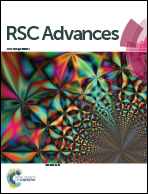Multifunctional LaPO4:Ce/Tb@Au mesoporous microspheres: synthesis, luminescence and controllable light triggered drug release†
Abstract
Uniform LaPO4:Ce/Tb mesoporous microspheres (MMs) have been successfully prepared by a facile mass production co-precipitation process under mild reaction conditions, without using any surfactant, catalyst or further heating treatment. Then, Au nanoparticles (NPs) were conjugated to polyetherimide (PEI) modified LaPO4:Ce/Tb MMs by electrostatic interactions. It was found that as-prepared LaPO4:Ce/Tb@Au composite consists of well-dispersed mesoporous microspheres with high surface area and narrow pore size distribution. Upon ultraviolet (UV) excitation, LaPO4:Ce/Tb and LaPO4:Ce/Tb@Au MMs exhibit the characteristic green emissions of Tb3+ ions. In addition, the good biocompatibility and sustained doxorubicin (DOX) release properties indicate its promise as a candidate in cancer therapy. In particular, under UV irradiation, a rapid DOX release was achieved due to the photothermal effect of Au NPs derived from the overlap of the green emission of Tb3+ and the surface plasmon resonance (SPR) band of gold NPs at about 530 nm. The MTT assay, cellular uptaken images, the anti-tumor therapy in vivo, and the histology examination results further proved that this novel multifunctional (mesoporous, luminescent, and thermal effect) drug delivery system should be a suitable candidate for cancer therapy carriers.


 Please wait while we load your content...
Please wait while we load your content...